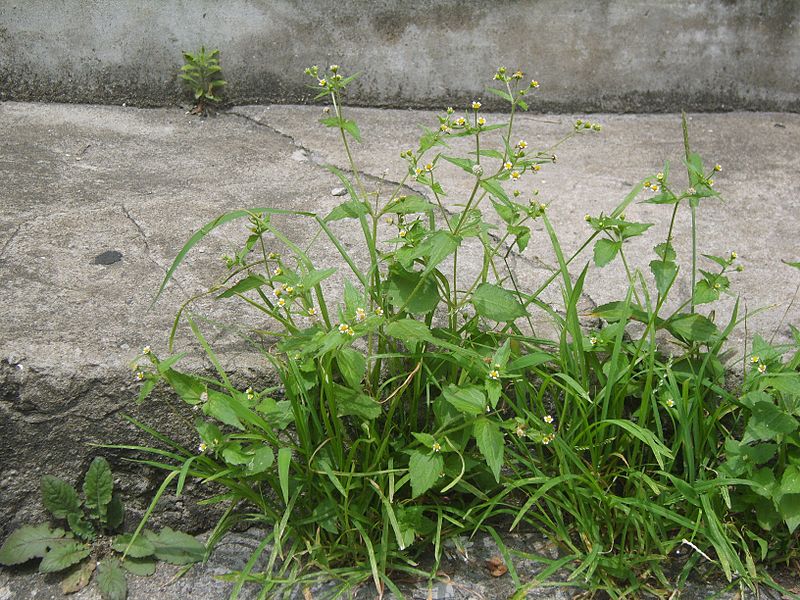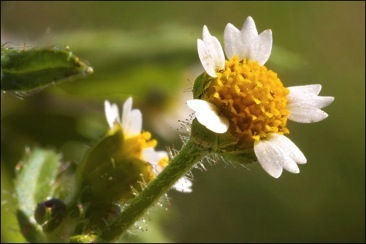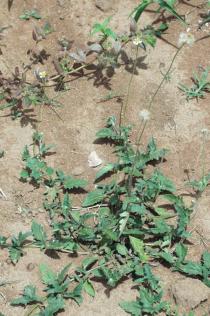
Galinsoga, “Gallent Soldiers” aka Quickweed grows up, it’s toxic look-alike crawls.
Galinsoga ciliata: Quickweed is fast food
Quickweed does not look edible or gallant. In fact, it looks like a daisy that lost a fight. But it, and a close cousin, G. parvifolia, are good pot herbs. There is a potentially toxic look alike, Tridax procumbens, “Coat Buttons” which is more viney, and low growing except for flower stalk. Unfortunately the blossoms of Galinsoga ciliata and Tridax procumbens are nearly identical so you have to look at the rest of the plant to make sure you have the Galinsoga. It is found nearly everywhere in North America except the desert southwest (and sparingly in warm southern states.)
Beside roundish older leaves, Galinsogas have (usually but not always) five widely spaced petals with indented tips. A native of Central and South American, Galinsoga ciliata (gal-in-SOH-guh sil-ee-ATE-uh aka G. quadriradiata) is a little plant that has gone a long ways. It was introduced to Kew Gardens in England in 1796 and not only has naturalized there but escaped to the continent as well. That makes some sense in that one plant in a season can produce 7500 seeds. As a new comer to not only the northern United States and Europe it does not have an extensive foraging history outside of its native region. However, as soon as it got to China it became a prime pot herb. The entire plant is eaten except the root. However the leaves are the best part. For an ugly little plant it has great taste. Pick a lot because it loses some size in the cooking.
Nutritionally the leaves of the Galinsoga per 100g edible portions are: 88.4g water, 37 calories, protein 3.2g, fat 0.4g, carbs 5.2g, fiber 1.1.g, calcium 284 mg, magnesium 60 mg, potassium 58 mg, iron 5.3 mg, zinc 1.3. mg, carotene 4 mg, vitamin C 6.7 mg, thiamin 0.08 mg, riboflavin 0.21 mg, and niacin 1.21 mg.
Galinsoga was named after Mariano Martinez Galinsoga, a Spanish physician and botanist in the 18th century. Ciliata means fringed with hair. Parvifolia means small flowers. The plant’s nick name in England is “gallant soldiers.” In Brazil it is known as botão-de-ouro. G. parvifolia is toxic to goats, apparently among the few plants that are.
Green Deane’s “Itemized” Plant Profile
IDENTIFICATION: Quickweed is identified by its opposite, oval, coarsely toothed leaves on opposite-branched stems. Its small flower heads have a yellow disk and five (or four) three-toothed white tiny petals (occasionally pink.) To two feet tall. Its toxic look-alike, Tridax, is ground hugging except for the flower stalks, see photo upper right. Remember, Galinsogas grows up, the entire plant. The Tridax grows low except for the flower stalk which grows up. Do not eat the Tridax. The blossoms resemble each other closesly so don’t use just the blossoms for identification.
TIME OF YEAR: May through fall in northern areas, nearly year round in Florida
ENVIRONMENT: Waste ground, cultivated areas, roadsides, gardens, dooryards lowland fields. However, it prefers damp rich soil with plenty of sunshine. (The government lists toxic Tridax as only growing in central and south Florida but eleven states consider it a “pest”: Alabama, California, Florida, Hawaii, Massachusetts, Minnesota, North and South Carolina Oregon, Texas and Vermont. )
METHOD OF PREPARATION: Cooked green. Put in boiling water for 10/15 minutes. Excellent with butter, salt and pepper. Dried leaves can be used for flavoring. G. parvifolia being less hairy is used as a salad green as well. The juice and leaf paste of the Tridax procumbens can be used to stop bleeding wounds.




